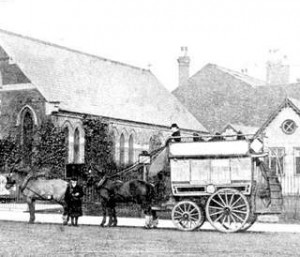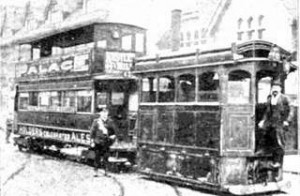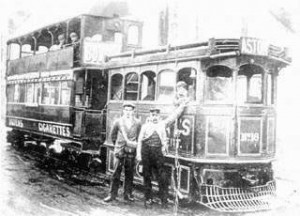However in 1904, Handsworth had its own little war with the South Staffordshire Tramways Co. which had begun electric traction on the overhead wire system as early as 1893. By 1902, this company had electrified its route through West Bromwich to the New Inns, the portion between “The Woodman” at the West Bromwich boundary and the New Inns being in Handsworth. A dispute arose between the Company and Handsworth Urban District Council, whose engineer was directed to get steam up and place the Council steam-roller across the tram tracks at the boundary with West Bromwich. Eventually peace ensued and the South Staffordshire electric trams continued to the New Inns, connecting with the City of Birmingham Tramway Company’s cable cars to Colmore Row.
The latter cars were reaching the end of their useful life, the Company’s lease was running out, and Handsworth was about to be incorporated into Birmingham, so electrification of the route was begun. Birmingham Corporation electric trams, on behalf of Handsworth U.D.C., began to run over the former cable tramway on 1st July 1911 the route being extended to West Bromwich where the South Staffordshire cars terminated. As Handsworth was not yet officially part of Birmingham, the traction poles on Soho Road and Holyhead Road accordingly bore the Staffordshire knot with the initials H.U.D.C., as did those along Birchfield Road.
The opening of the Oxhill Road branch in 1912, and the Lozells circular services via Villa Road and Hamstead Road a month earlier, were further developments. The last tramway extension in Handsworth was from Villa Cross to the top of Villa Road in 1913 but no junction was ever made with the Soho Road tracks there.
The Birmingham & Midland Omnibus Co. Ltd. began operation again in 1912 with Tilling-Stevens petrol-electric motor buses, this time with success, and one of their routes was from the Ivy Bush Hotel on Hagley Road to Handsworth Wood via Hockley. In 1914 Birmingham Corporation took over all the routes within the city boundary. In 1924 there were through services from Colmore Row through West Bromwich to Dudley and Wednesbury.
In 1926 the complete Outer Circle (No.11) service was started, the route through Handsworth being as it is today.
April 1939 saw the end of the main Handsworth trams when omnibuses took over at Hockley depot. The Perry Barr route No.6 lasted ten years longer served to the end by the famous “Aston Bogies”, six of which had survived an air-raid in 1941 when Miller Street depot suffered damage. These were the original cars of 1904, at first open-top, but rebuilt with top covers and otherwise brought up-to-date. The Villa Road service No.5. lasted until 1950.
Apart from the General Strike of 1926, the only interruption to the tramway service in Handsworth were the overturning of a South Staffordshire car in Holyhead Road below the New Inns In 1922, and gale damage in 1928 when the temporary roof was blown off the Grammar School extension in Grove Lane and brought down the overhead wires.



